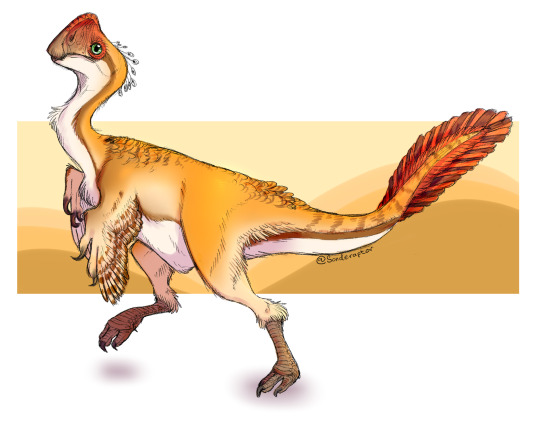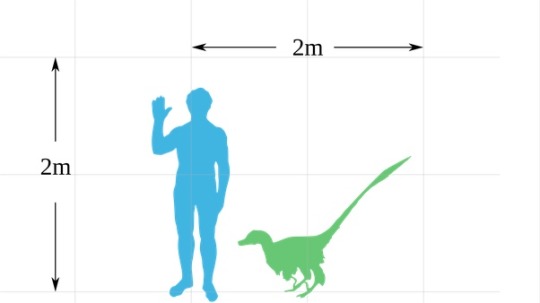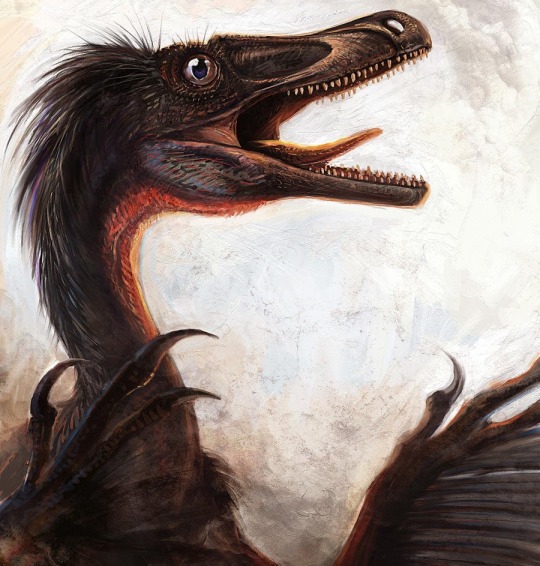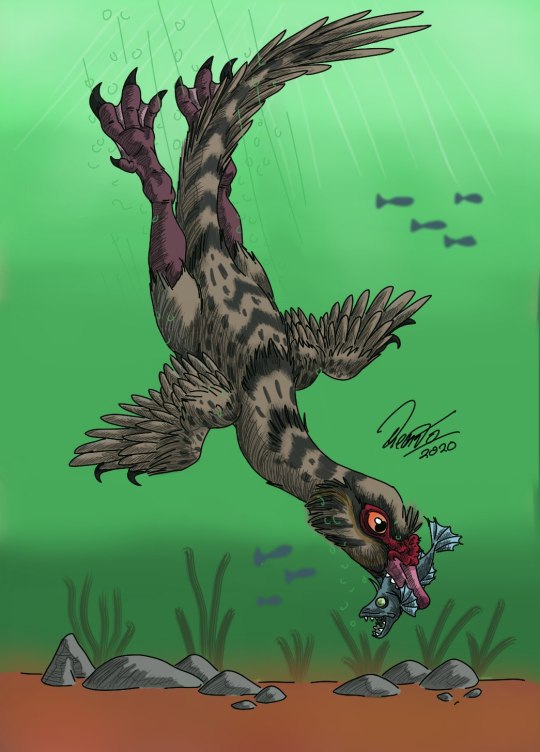#Djadochta Formation
Text

A Solar Eclipse is coming! How will the dinosaurs react to it?
#paleoart#dinosaur#dinosaurs#paleontology#dinosaur artwork#dinosaur art#velociraptor#protoceratops#djadochta formation#solar eclipse#solar eclipse 2024#ceratopsidae#ceratopsian#theropod dinosaurs#theropod dinosaur#theropoda#theropods#theropod#ceratopsia#dinosaur illustration#dinosaurs are cool
264 notes
·
View notes
Text

Oviraptor philoceratops of the Djadochta Formation
#art#sketch#dinosaur#illustration#paleoart#drawing#dinoart#animals#reptile#bird#animal art#theropod#dinosaurs#digital art#cute#oviraptor#birds#raptor#Djadochta Formation
148 notes
·
View notes
Text

A camel caravan on the way to the Djadochta Formation, Bayn Dzak, Mongolia
By: James B. Shackelford
From: Natural History Magazine
1933
#bactrian camel#camel#camelid#ungulate#mammal#1933#1930s#James B. Shackelford#Natural History Magazine
37 notes
·
View notes
Text

#Archovember Day 27 - Udanoceratops tschizhovi
The leptoceratopsids are known for being small, pig-sized Late Cretaceous ceratopsians reminiscent of their more basal ancestors. But Udanoceratops tschizhovi took things to the next level, growing to the size of a hippopotamus, with the head and jaw strength to match. While assumed to be a herbivore like other ceratopsians, little is known about plants that grew in the Gobi Desert at the time of the Cretaceous, so it is unclear what types of plants it would have eaten. Its sharp beak, powerful jaws, and shearing/crushing teeth suggest a diet of relatively tough plants. Like other ceratopsians, particularly leptoceratopsians, Udanoceratops could have also opportunistically scavenged carcasses, nests, or even small mammals and young/weak dinosaurs for extra protein in its desert environment.

In the Djadochta Formation of Mongolia, Udanoceratops would have lived alongside the smaller, more numerous protoceratopsians Protoceratops and Bagaceratops. This was a mostly barren landscape, likely dotted by oases and arroyos that would have attracted smaller animals like nanhsiungchelyid land turtles, lizards like Gobiderma, frogs like Gobiates, crocodylomorphs like Artzosuchus, small mammals like Asiatherium and Mangasbaatar, and small theropods like the oviraptorosaur Avimimus. Udanoceratops was the largest animal around. Thus far, no predators large enough to take on an adult Udanoceratops have been found in its locality. The dromaeosaur Velociraptor could have snatched a baby Udanoceratops when the opportunity arose, but it would then risk the ire of this giant desert hippo with a staple remover for a head.
#my art#SaritaDrawsPalaeo#Udanoceratops tschizhovi#Udanoceratops#Leptoceratopsid#neoceratopsians#ceratopsians#ornithischians#dinosaurs#archosaurs#archosauromorphs#reptiles#Archovember#Archovember2023
26 notes
·
View notes
Text
Velociraptor Profile

Scientific Name: Velociraptor mongoliensis
Time Period: Late Cretaceous
Location: Djadochta Formation, Mongolia
Length: 1.5 - 2 meters (5 - 6.5 meters)
Weight: 12 - 18 kg (26 - 40 lb)
Diet: Other dinosaurs, small mammals and reptiles
Exhibit: Velociraptor Dunes, Gobi Desert
As everyone knows, Velociraptor is not what the famous movie Jurassic Park would have you believe. Rather than a ‘6 foot turkey’ it instead a turkey-sized dinosaur that was discovered in 1923 by Peter Kaisen of the American Museum of Natural History. With two known species and dozens of specimens since, the Velociraptor was a decently well known species before the de-extinction process.
Velociraptors are surprisingly not pack hunters, preferring to hunt alone rather than with a group. However, they are known to create small alliances with other non-mate individuals in the event of a shared interest, such as stalking down a group of young pterosaurs. Mainly solitary aside from mates and young, the Velociraptor is a feared predator by many, but prefers to sleep the day away in a cool cave.
The Gobi Desert Exhibit in New Horizons has two Velociraptors in it’s enclosure; a lesbian pairing in fact! Living in their recreated habitat along with any in-need young from other paleozoological locations, Ot and Tengri spend their time playing with their enrichment items and hunting the rats we release in the enclosure for them to feed on. Tengri is also an Animal Ambassador, as depicted in the picture above! Come see them soon at New Horizons!
Reference Images Used!
DISCLAIMER: Yes I traced. Sorry, but I can never get proportions right. ALL THE RIGHTS OF THE ORIGINAL DRAWING GO TO THE ORIGINAL ARTISTS!!! I used the outlines and then made my own adjustments. I WILL BE ADVANCING MY ARTWORK AS I CONTINUE, AND LIKELY REPLACING THESE OLD OUTLINES WITH NEW ART THAT IS MY OWN




#new horizons paleozoological sanctuary#paleozoo#prehistoric planet#artists on tumblr#digital art#digital illustration#dinosaurs#geology#goth#natural history#paleontology#choker#paleoart#dinos#realistic dinosaur zoo#dinosaur#velociraptor#velociraptor mongoliensis#velociraptor art#zoo
22 notes
·
View notes
Text
Velociraptor mongoliensis
('swift plunderer, from Mongolia')
Dromaeosauridae Velociraptorinae
The Velociraptor of modern myth might be an interesting animal, but so were the real ones.
We see a feathered terror weighing ~45 kg, or about the size of a wolf, built for speed and agility. But unlike wolves, this was likely not a predator that hunted in packs--the diets of Velociraptor changed as they aged, which isn't consistent with packing animals who tend to eat what they're served or go hungry. Packing also necessitates a social complexity that Velociraptor were just not capable of, which brings me to my next point: Velociraptor were smart, but non-avian dinosaur-smart, not modern bird-smart, and certainly no where near 'Jurassic Park'-smart.
Their senses were tuned, especially for smell and sight. They had large sclerotic rings (a bone circle in the eyehole to support the eyeball), which usually indicates a nocturnal lifestyle.
As for the awesome 'sickle claw' on the second toe, it was almost certainly used to pin down prey while feeding--like a hawk--rather than for slashing and disemboweling.
Velociraptor is represented by two species: the type species is V mongoliensis, of the Djadochta Formation, Mongolia; and across the border in the Bayan Mandahu Formation of Inner Mongolia, China, we have V. osmolskae, named in honour of famed palaeontologist Halszka Osmólska.
Upper Cretaceous, ~75 - 71 Ma.
~
Artwork by Cheung Chung Tat.

Daily Dino Fact #41
2 notes
·
View notes
Text
There’s a little bit of temporal messing about going on — it seems kinda like the true dune desert of the Djadochta and equivalent formations are being combined with the slightly younger, less arid Nemegt. (But if you ignore the genus names being used you wouldn’t bat an eye…)
3 notes
·
View notes
Text
Walking in the Djadochta Formation
Walking in the Djadochta Formation. Flaming Cliffs Mongolia, 73 Million years ago.

View On WordPress
#adobe photoshop#artistatwork#Commissions Open#Concept Art#cretaceous#Cretaceous period#desert#Digital Art#DigitalPainting#dinosaur#Dinosaur Art#dinosaurs#Environment Design#Feathered Dinosaurs#Gobi Dessert#Kryptobaatar#landscape#landscape art#Mongolia#oviraptor#paleo art#paleontology#prehistoric life#prehistoric mammals#protoceratops#raptors#velociraptor#Wacom Tablet
0 notes
Photo

Day 28: Udanoceratops tschizhovi. Another, but yet largest known leptoceratopsidae of the Djadochta formation. #DjadochtaJuly #paleoart #sketches #artistsoninstagram #myart #sketch #sketchbook #udanoceratops #udanoceratopstschizhovi #leptoceratopsidae #ceratopsia #marginocephalia #ornithischia #dinosauria #dinosaurs https://www.instagram.com/p/CgjEmNPuaeO/?igshid=NGJjMDIxMWI=
#djadochtajuly#paleoart#sketches#artistsoninstagram#myart#sketch#sketchbook#udanoceratops#udanoceratopstschizhovi#leptoceratopsidae#ceratopsia#marginocephalia#ornithischia#dinosauria#dinosaurs
0 notes
Photo

Oviraptorid Adult and Chicks
Late Cretaceous, Djadokhta Formation, Asia
An adult Oviraptorid leads three chicks through the desert sands. Based on skeletons of Citipati and the Zamyn Khondt specimen.
Digital painting with some photographic elements (my own photos), using Photoshop and a Wacom tablet.
#oviraptor#oviraptorosaur#oviraptorid#Citipati#ZamynKhondt#Djadochta Formation#late cretaceous#paleontology#paleoart#dinosaur#theropod#natural history#Illustration#science#digital art#feathered dinosaur#chicks#hatchlings#desert#Mesozoic
818 notes
·
View notes
Photo

In a remote area between China and Russia, within the nomadic lands of Mongolia, there exists a clustering of red and orange sandstone rocks dating back to the Cretaceous Period (75 million years ago). Known as The Flaming Cliffs, this location gets its name due to its color changing to a deep, shimmering red when the sunsets upon it.
If you're a fan of the movie Jurassic Park or Raiders of the Lost Ark, then you'll be interested to know that this is the site where paleontologist Roy Chapman Andrews (the inspiration for Indiana Jones) discovered the first dinosaur egg back in the 1920s. Other significant dinosaur fossil finds have been the Protoceratops, Pinacosaurus and Velociraptor, as well as the bones of early mammals. This is because The Flaming Cliffs is part of the Gobi Desert, an area which was once an inland sea teeming with life, until a series sandstorms and avalanches caused sudden death on a massive scale, preserving all remains. And since these events, which occurred some 71-75 million years ago, the area has seen little change in climate, due to the fact it is so far remote from any significant water source that very little rainfall has reached it. Thus taking a walk around these rocky cliffs is literally like taking a step back in time.
Or at least so I'm told…I dunno for sure…I wasn't around to know what the area looked back then and that’s what the guide tells you when you get there. But one thing that is for certain, is that if you comb the area even now today, you will still find new, undiscovered fossils buried within the dirt and sand. But Dinosaur junkies be warned, leave whatever you find behind otherwiseborder officials will seize your loot and fine you a hefty fee.
Sadly, the Gobi Desert is expanding at an alarming rate through desertification, at several thousand kilometers per year, due to pollution, deforestation, and climate change. Efforts have been made to stop its expansion by the Chinese government, but with so far, minute success.
“𝙂𝙤𝙙 𝙘𝙧𝙚𝙖𝙩𝙚𝙨 𝙙𝙞𝙣𝙤𝙨𝙖𝙪𝙧𝙨. 𝙂𝙤𝙙 𝙙𝙚𝙨𝙩𝙧𝙤𝙮𝙨 𝙙𝙞𝙣𝙤𝙨𝙖𝙪𝙧𝙨. 𝙂𝙤𝙙 𝙘𝙧𝙚𝙖𝙩𝙚𝙨 𝙢𝙖𝙣. 𝙈𝙖𝙣 𝙙𝙚𝙨𝙩𝙧𝙤𝙮𝙨 𝙂𝙤𝙙. 𝙈𝙖𝙣 𝙘𝙧𝙚𝙖𝙩𝙚𝙨 𝙙𝙞𝙣𝙤𝙨𝙖𝙪𝙧𝙨.” ~ 𝘿𝙧. 𝙄𝙖𝙣 𝙈𝙖𝙡𝙘𝙤𝙡𝙢 (𝙅𝙪𝙧𝙖𝙨𝙨𝙞𝙘 𝙋𝙖𝙧𝙠)
𝙇𝙄𝙆𝙀 if you are a Warrior who has a deep dinosaur within you, just ROARing to get out!
𝗦𝗛𝗔𝗥𝗘 this to your loved one…ROAR means "I Love You" in Dinosaur.
𝗙𝗢𝗟𝗟𝗢𝗪 for Daily Inspirational Wisdom and Strategies from Sun Tzu's "The Art of War".
#sun tzu#the art of war#art of war#mongolia#gobidesert#flaming cliffs#djadochta#djadochta formation#mongolian#dinosaur#paleontology#roy chapman andrews#nomadic
4 notes
·
View notes
Text

A pair of Protoceratops and a lone Velociraptor trek across the wide expanse of sand dunes 75 million years ago in what is now the Djadochta Formation of Mongolia
#dinosaur#paleoart#dinosaurs#velociraptor#protoceratops#sand dunes#desert#djadochta formation#mongolia#paleontology#paleontography#dromaeosaur#dromaeosaurid#ceratopsian
401 notes
·
View notes
Text
Tarchia tumanovae Park et al., 2021 (new species)

(Skull of Tarchia tumanovae, from Park et al., 2021)
Meaning of name: tumanovae = for Tat'yana Tumanova [Russian paleontologist]
Age: Late Cretaceous (Campanian–Maastrichtian)
Where found: Nemegt Formation, Ömnögov, Mongolia
How much is known: Partial skeleton of one individual, including the skull, partial hips, and the back half of the tail.
Notes: T. tumanovae was an ankylosaurine ankylosaur, a group of armored dinosaurs known for their distinctive tail club. Two other species in the genus Tarchia were previously recognized, both from the Late Cretaceous of Mongolia. These were T. kielanae from the Barun Goyot Formation and T. teresae, also from the Nemegt Formation. The three species of Tarchia differ from one another in details of their skull.
Members of the genus Tarchia had relatively narrow snouts by ankylosaurine standards, suggesting that they were fairly choosy about what plants they fed on. The species known from the Nemegt Formation especially would have been part of a large community of big herbivorous dinosaurs (including hadrosaurids, titanosaurs, and the plant-eating theropods Deinocheirus and Therizinosaurus), so it is possible that increased competition promoted their more selective feeding habits. In contrast, ankylosaurines that have been found in the Djadochta Formation (also from the Late Cretaceous of Mongolia), where few other large herbivores have been discovered, tended to have broader snouts, which suggests that they were more indiscriminate feeders.
The type specimen of T. tumanovae exhibits injuries to its ribs and tail. Its describers suggest that these may have been sustained in fights with other ankylosaurines, providing some support for the hypothesis that ankylosaurines used their tail clubs to fight against members of their own species, instead of solely for defense against predators.
Reference: Park, J.-Y., Y.-N. Lee, Y. Kobayashi, L.L. Jacobs, R. Barsbold, H.-J. Lee, N. Kim, K.-Y. Song, and M.J. Polcyn. 2021. A new ankylosaurid from the Upper Cretaceous Nemegt Formation of Mongolia and implications for paleoecology of armoured dinosaurs. Scientific Reports 11: 22928. doi: 10.1038/s41598-021-02273-4
101 notes
·
View notes
Text


#Archovember Day 16 - Shuvuuia deserti
The highly specialized Alvarezsaurids got their chance at fame this past year when the world fell in love with Prehistoric Planet’s Mononykus. Initially assumed to be flightless birds, Alvarezsaurids are now considered maniraptorans, existing in their own clade apart from the pennaraptorans. They were long-legged and seemed to be built for speed, with massive breast and arm muscles for digging and tearing with their short, massively thumbed forelimbs. They appear to have filled a similar niche to anteaters, aardvarks, and pangolins, tearing into ant and termite mounds with their thick claws and lapping up the insects with their tube-shaped, unusually mobile snouts.
About half the size of the now famous Mononykus was Shuvuuia deserti, meaning “desert bird.” Shuvuuia lived in Late Cretaceous Mongolia. It had good night vision and owl-like ears, and was probably an owl-like nocturnal hunter, using it’s amazing hearing to track down the scratching of tiny animals beneath the soil. Its night vision was so great that it could probably hunt in complete darkness. The position of its ears lead some to believe that it also had an owl-like facial disk of feathers. As Shuvuuia was preserved with fluffy, down-like feathers, this is entirely possible.
The Djadochta Formation, where Shuvuuia have been found, seems to have been dominated by Protoceratops. Shuvuuia would have also lived alongside the ankylosaurids Pinacosaurus and Minotaurasaurus, the large leptoceratopsid Udanoceratops, the halszkaraptorines Halszkaraptor and Mahakala, the ornithomimid Aepyornithomimus, the oviraptorids Citipati, Khaan, and Oviraptor, and the pachycephalosaur Goyocephale, along with many species of lizard and small mammal. Shuvuuia had many predators to watch out for as well, including an array of troodontids like Gobivenator, Almas, and Saurornithoides, and the dromaeosaurs Tsaagan and Velociraptor.
140 notes
·
View notes
Note
Did protoceratops and velociraptors live at the same time? Because if so I know where I'm going once time travel is invented
They better have, seeing as this fossil exists of the two species killed and buried while fighting to the death:

For those who can’t quite tell what’s going on - the Protoceratops is trampling the Velociraptor, with the latter’s wing in its mouth, and the Velociraptor has the claws of its other wing raking the Protoceratops’s face and aiming its retractable toe-claw into the ceratopsian’s neck. It’s a stunning example of behaviour preserved real-time in the fossil record.
How did this happen?
These animals both lived about 75 million years ago in what is now Mongolia; they are found in rocks known as the Djadochta (alternately, Djadokhta) formation. The Djadochta represents a sandy, arid desert not unlike the modern Gobi (though the area was not a desert the entire time in between). This desert seems to have been prone to sandstorms and dune collapses; as a result, we have a fascinating case wherein animals did not experience the traditional pattern of “death, burial, fossilisation”, but rather many of the fossils in the Djadochta are animals that were buried alive.
So we have fossils like the above, with a Velociraptor and a Protoceratops literally fighting to the death. It’s one of, if not the, most spectacular fossils of all time.

The formation also preserves amazing direct evidence of many other behaviours. Oviraptorosaurs, so-called “egg thieves” because the initial fossil was found over a nest, were in fact caring parents. We know this because multiple fossils have been found of parents (likely fathers) sitting on nests of their own eggs, bravely protecting their babies to the end, waiting for the end of a sandstorm they did not live to see.

Pinacosaurus was an ankylosaur found in the Djadochta. Their juveniles lived together in small herds. When a sandstorm arose, the group tucked their arms and legs under them and hunkered down; as the wind and sand beat against their armoured back they too waited for the storm to end, and like the Citipati family, sometimes they did not live to see it.

4K notes
·
View notes
Photo

(Note: I am not a professional paleontologist or even biologist. I am just and amateur paleoartist and enthusiast. If my infos are off in some way, feel free to correct them ^^)
-
DINOCEMBER
7 - Halszkaraptor escullei (from Latin "Halszka's hunter" in honor of the Polish paleontologist Halszka Osmólska)
- Late Cretaceous (75-71 Ma BCE)
- Djadochta Formation, Ömnögovi, Mongolia
Formally named in 2017, the Halszkaraptor is one of the great discoveries of the 2010s among non-avian dinosaurs, being the second of these animals with definitive proof of a semi-aquatic lifestyle - the first being the Spinosaurus in 2014. Approximate size of a mallard duck, this little dromaeosaur - or "raptor" - inhabited a region of streams and ponds in the middle of the seasonal semi-arid Djadochta formation, or "Flaming Hills" in the Mongolian language, presenting a series of characteristics that indicate such adaptations , with a center of gravity closer to the front of the body, which facilitates swimming and diving movements, in addition to a very long neck in relation to the size of the body and a more upright posture than that of others in its clade, in addition to from possibly having complex nerve endings in its snout to detect prey, more or less like a platypus.
Cau et al. (2017) suggests that the Halszkaraptor would live similarly to the current mergansers, especially the analogy between the long neck and short body, in addition to the bird's serrated beak compared to the dinosaur's conical teeth, curved backwards to catch the slippery prey. The authors of the discovery also point to a swimming mode more similar to that of penguins than to ducks and grebes, using the short forelimbs as the main form of propulsion.
There is a small error that I noticed only after finishing this drawing: Halszkaraptor's nostrils are located on the front of the beak, not close to the eyes like a duck. Sorry about that .
- Color scheme based on a Fishing Cat (Prionailurus viverrinus) and a Muscovy Duck (Cairina moschata)
#dinocember#dinocember2020#halszkaraptor#duck boy#ducktales woo hoo#dinosaur#raptor#dromaeosaur#theropod#paleobiology#paleoart#paleoillustration#paleontology#sciart#science illustration#nature#digital art#digital drawing#artists on tumblr#Digital Artists#creature art#creature design#creature concept#dinovember#cretaceous#late cretaceous#mongolia#djadochta formation#flaming cliffs#birb
25 notes
·
View notes